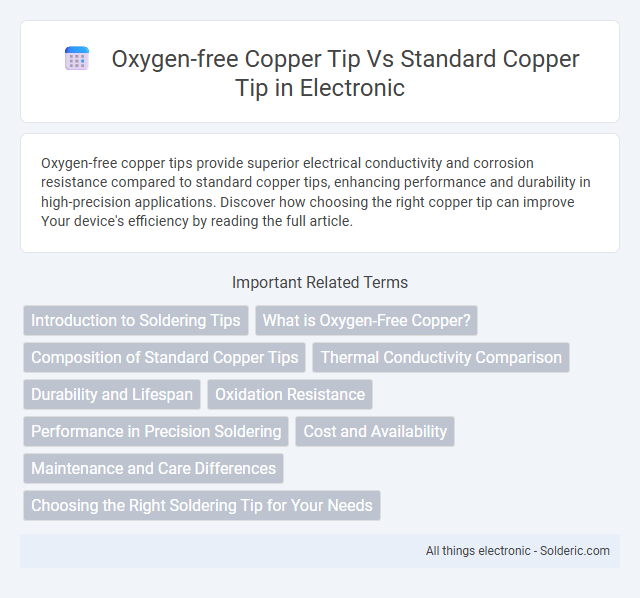Oxygen-free copper tips provide superior electrical conductivity and corrosion resistance compared to standard copper tips, enhancing performance and durability in high-precision applications. Discover how choosing the right copper tip can improve Your device's efficiency by reading the full article.
Comparison Table
| Feature | Oxygen-Free Copper Tip | Standard Copper Tip |
|---|---|---|
| Purity | 99.99% Copper, minimum oxygen content | Approx. 99% Copper, higher oxygen content |
| Electrical Conductivity | Superior (above 100% IACS) | Standard (97-99% IACS) |
| Thermal Conductivity | Higher thermal conductivity for efficient heat dissipation | Lower thermal conductivity |
| Durability | More resistant to oxidation and corrosion | Prone to oxidation over time |
| Cost | Higher cost due to purity and processing | Lower cost, widely available |
| Typical Applications | High-performance electronics, precision soldering | General-purpose soldering and electrical applications |
Introduction to Soldering Tips
Oxygen-free copper (OFC) soldering tips offer superior thermal conductivity and corrosion resistance compared to standard copper tips, ensuring more efficient heat transfer and longer tip lifespan. Standard copper tips, while highly conductive, tend to oxidize quickly, leading to reduced performance and frequent replacements. Choosing oxygen-free copper tips enhances soldering precision and durability, especially in high-demand electronic assembly tasks.
What is Oxygen-Free Copper?
Oxygen-free copper (OFC) is a high-purity copper material with oxygen levels below 0.001%, reducing impurities that can degrade electrical conductivity and durability. Unlike standard copper tips, which contain trace amounts of oxygen and other contaminants, OFC tips provide superior thermal and electrical performance due to their enhanced purity. For your electronics or soldering applications, choosing an oxygen-free copper tip ensures better heat transfer and longevity compared to standard copper alternatives.
Composition of Standard Copper Tips
Standard copper tips primarily consist of electrolytic tough pitch (ETP) copper, which contains approximately 99.9% copper and trace amounts of oxygen, typically around 0.02% to 0.04%. The presence of oxygen in standard copper tips can lead to the formation of copper oxides during welding, affecting electrical conductivity and thermal performance. In contrast, oxygen-free copper tips are manufactured with minimal oxygen content, enhancing purity and improving durability and conductivity in high-performance applications.
Thermal Conductivity Comparison
Oxygen-free copper tips offer superior thermal conductivity compared to standard copper tips due to their higher purity and reduced oxygen content, which minimizes impurities that hinder heat transfer. This enhanced thermal conductivity ensures more efficient heat dissipation, leading to improved performance and durability in applications such as soldering and electrical contacts. Your choice of an oxygen-free copper tip can significantly impact temperature stability and precision in heat-sensitive tasks.
Durability and Lifespan
Oxygen-free copper tips exhibit superior durability and a longer lifespan compared to standard copper tips due to their enhanced purity and reduced oxygen content, which minimizes oxidation and corrosion. This results in better resistance to wear and consistent performance over time, making them ideal for high-precision applications. Your equipment benefits from sustained conductivity and reduced maintenance when using oxygen-free copper tips.
Oxidation Resistance
Oxygen-free copper tips exhibit significantly higher oxidation resistance compared to standard copper tips due to their reduced oxygen content, which prevents the formation of copper oxides on the surface. This enhanced resistance ensures better electrical conductivity and durability, especially in high-temperature or corrosive environments. Choosing an oxygen-free copper tip for Your applications results in longer-lasting performance and reduced maintenance.
Performance in Precision Soldering
Oxygen-free copper tips offer superior thermal conductivity compared to standard copper tips, enabling faster heat transfer and more consistent temperature control during precision soldering tasks. This enhanced thermal performance reduces the risk of thermal damage to delicate components by maintaining stable soldering temperatures. Consequently, oxygen-free copper tips provide improved solder joint quality, making them the preferred choice for high-precision electronics assembly.
Cost and Availability
Oxygen-free copper tips generally cost more due to higher purity levels and more complex manufacturing processes compared to standard copper tips, which are widely available and inexpensive. The increased demand for oxygen-free copper in specialized applications causes price fluctuations and limited supply in some regions. Standard copper tips remain more accessible for mass-market use, making them the preferred choice for budget-sensitive projects.
Maintenance and Care Differences
Oxygen-free copper tips require less frequent oxidation treatment compared to standard copper tips, resulting in easier maintenance and prolonged tip life. Standard copper tips tend to accumulate more oxide buildup, necessitating regular cleaning to ensure optimal performance and prevent corrosion. Proper care of your oxygen-free copper tip can enhance soldering precision and reduce downtime caused by tip degradation.
Choosing the Right Soldering Tip for Your Needs
Oxygen-free copper tips provide superior thermal conductivity and corrosion resistance compared to standard copper tips, making them ideal for precision soldering tasks that require consistent heat transfer. Standard copper tips heat up quickly but may wear out faster due to oxidation and impurities, which can affect soldering quality over time. Choosing the right soldering tip depends on your project's demands and frequency; for durability and high performance, oxygen-free copper tips offer better longevity and efficiency.
Oxygen-free copper tip vs standard copper tip Infographic

 solderic.com
solderic.com